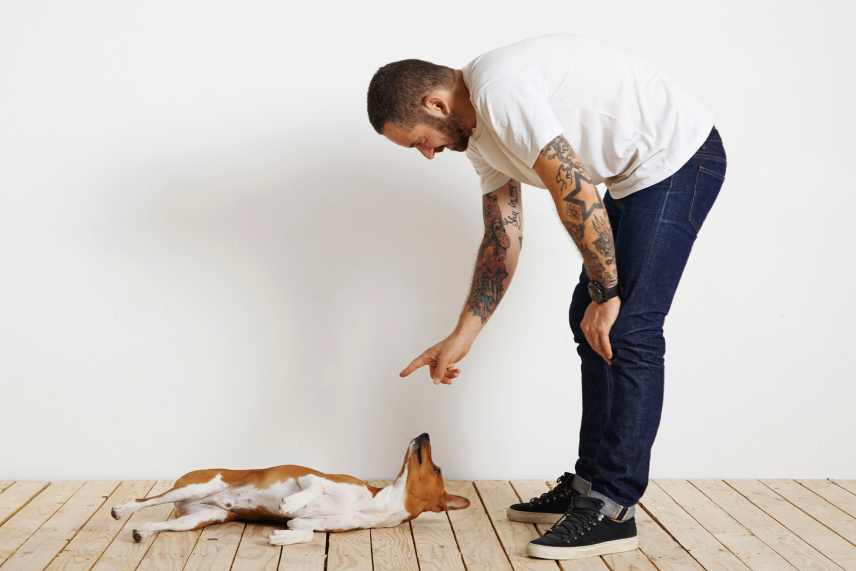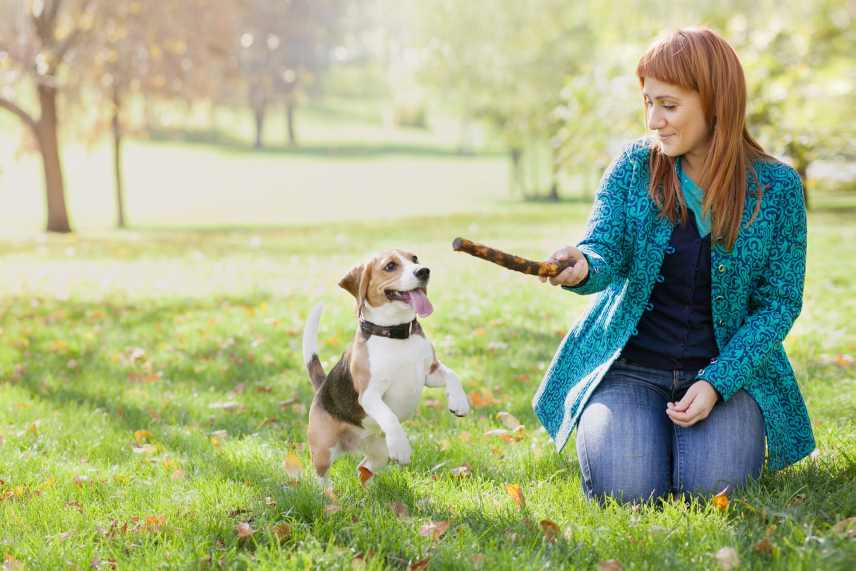Teaching a dog new tricks can be a fun and rewarding experience for both the dog and the owner.
One of the most popular tricks is to teach a dog how to roll over. This trick involves getting the dog to lie down on its side and then roll onto its back. It may seem like a difficult task, but with patience and consistency, any dog can learn this trick.
Before starting the training process, it is important to make sure that the dog is comfortable with basic commands such as sit, stay, and lie down. These commands will serve as a foundation for teaching the roll over trick. It is also important to have plenty of treats on hand as positive reinforcement is key to successful training. With these basics in place, the owner can begin to teach the dog how to roll over.

Understanding Dog Behavior
Canine Learning Processes
Dogs have a unique ability to learn new behaviors through various processes. One of the most common ways dogs learn is through classical conditioning. This is when a dog learns to associate a particular stimulus with a specific response. For example, a dog may learn to associate the sound of a treat bag with receiving a treat, causing them to become excited and eager to perform a trick.
Another way dogs learn is through operant conditioning. This is when a dog learns a behavior based on the consequences of that behavior. For example, if a dog performs a trick and receives a treat as a reward, they are more likely to repeat that behavior in the future.
Importance of Positive Reinforcement
Positive reinforcement is a crucial aspect of teaching a dog how to roll over. This training technique involves rewarding a dog for performing desirable behaviors. Rewards can include treats, praise, or playtime. By using positive reinforcement, dogs learn that performing certain behaviors leads to positive outcomes, making them more likely to repeat those behaviors in the future.
It’s important to note that punishment-based training techniques can have negative consequences for a dog’s behavior. These techniques can cause anxiety, fear, and aggression in dogs, making them less likely to learn new behaviors.
In conclusion, understanding a dog’s learning processes and using positive reinforcement are essential for teaching a dog how to roll over. By using these techniques, dog owners can create a positive and enjoyable training experience for their furry friend.
Preparation for Training
Choosing the Right Environment
Before starting the training, it is important to choose the right environment. The training area should be quiet and free from distractions, such as other dogs, people, and loud noises. This will help your dog to focus and learn more easily.
It is also important to choose an area with enough space for your dog to move around comfortably. A room or a backyard can be a good option. Make sure to remove any items that your dog might knock over or get distracted by.
Gathering Necessary Supplies
To teach your dog how to roll over, you will need a few supplies. These include:
- Treats: Use small, soft treats that your dog loves. These will serve as a reward for good behavior.
- Clicker: A clicker is a small device that makes a clicking sound. You can use it to mark the behavior you want your dog to repeat.
- Leash: A leash can help you control your dog’s movements and keep them focused on the training.
- Towel or mat: A towel or mat can provide a comfortable surface for your dog to lie on and roll over.
Make sure to have these supplies ready before you start the training session. This will help you stay organized and focused on teaching your dog how to roll over.
Basic Training Commands
Mastering ‘Sit’ and ‘Stay’
Before teaching a dog tricks, it is important to establish a solid foundation of basic commands. Two essential commands to master are “sit” and “stay.” These commands are useful not only for training but also for daily life situations such as crossing the street or meeting new people.
To teach a dog to sit, start by holding a treat close to its nose and slowly moving it up and over its head. As its head follows the treat, its bottom should naturally lower to the ground. Once it is in a sitting position, give it the treat and praise it with a positive tone of voice.
To teach a dog to stay, have them sit and then hold your hand up in front of their face like a stop sign. Say “stay” in a firm tone and take a step back. If the dog stays in place, give them a treat and praise them. Gradually increase the distance and duration of the stay command.
Introducing the ‘Roll Over’ Command
Once a dog has mastered the basic commands of “sit” and “stay,” it is time to introduce the “roll over” command. This trick can be a bit more challenging, but with patience and consistency, any dog can learn it.
To teach a dog to roll over, start by having it lie down. Hold a treat in front of its nose and slowly move it in a circular motion towards its shoulder. As it follows the treat, its body should naturally roll over onto its side. Once it is in this position, give it the treat and praise it.
Repeat this process, gradually moving the treat further towards their back until they roll over completely. It may take several training sessions for a dog to master this trick fully, so be patient and consistent with your training.
By mastering these basic training commands, dogs will not only be well-behaved and obedient, but also more receptive to learning new tricks and behaviors.
Step-by-Step Training Guide
Breaking it Down: Teach a Dog How to Roll Over Step-by-step
Before starting the training, it’s important to break down the roll over movement into smaller, more manageable steps. This will help your dog understand what is expected of them and make the training process less overwhelming.
First, teach your dog to lie down on command. Once they have mastered this, move onto getting them to roll onto their side. You can use treats to guide them into this position. Once they are comfortable with rolling onto their side, start guiding them into a full roll over.
Guiding Your Dog Through the Motion
To guide your dog through the motion of rolling over, start by giving the command “roll over” and gently guide them into the position. You can use treats to encourage them and reward them for their progress. Be patient and repeat the process until they are able to do it on their own.
It’s important to use positive reinforcement and avoid punishment during the training process. Punishing your dog can cause them to become fearful and less likely to learn.
Practicing Consistently
Consistency is key when it comes to dog training. Practice the roll over command with your dog every day, gradually increasing the difficulty as they become more comfortable with the movement.
It’s also important to keep training sessions short and fun. Dogs have short attention spans, so keeping sessions brief can help prevent them from becoming bored or frustrated.
By following these steps and practicing consistently, you can teach your dog how to roll over in a fun and positive way. Remember to be patient and celebrate your dog’s progress along the way.
Troubleshooting Common Issues
Dealing with Distractions
Teaching a dog to roll over can be a fun and rewarding experience, but it’s not always easy. One of the most common issues people face when trying to teach their dog this trick is dealing with distractions. Dogs are naturally curious animals, and they can easily become distracted by things going on around them.
To minimize distractions, it’s important to choose a quiet, distraction-free environment for training. This could be a room in your home or a quiet outdoor space. It’s also important to limit the number of people and other animals in the area during training sessions.
If your dog does become distracted during training, try using treats or toys to refocus their attention. You can also try using a verbal cue, such as “focus,” to get your dog’s attention back on you.
Overcoming Fear or Resistance
Another common issue people face when trying to teach their dog to roll over is fear or resistance. Some dogs may be hesitant to lie on their back or may be afraid of the movement involved in rolling over.
To overcome fear or resistance, it’s important to start slowly and gradually build up to the full trick. Begin by getting your dog comfortable with lying on their back. You can do this by gently stroking their belly and rewarding them with treats.
Once your dog is comfortable lying on their back, you can start to work on the rolling over motion. Start by gently guiding your dog’s head to one side and rewarding them with treats. Gradually increase the amount of pressure you use to guide your dog’s body until they are comfortable rolling over completely.
Remember, teaching a dog to roll over takes time and patience. With consistent training and positive reinforcement, your dog will eventually learn this fun trick.
Health and Safety Considerations
Recognizing Physical Limitations
Before attempting to teach a dog how to roll over, it is important to recognize any physical limitations the dog may have. Dogs with arthritis, joint problems, or other physical issues may not be able to perform this trick comfortably or safely. It is recommended to consult with a veterinarian before attempting to teach a dog with known physical limitations.
Ensuring Comfort and Safety
In order to ensure the safety and comfort of the dog, it is important to use positive reinforcement techniques and to avoid any physical force or punishment. The dog should be in a safe and comfortable environment with enough space to move around freely.
It is also important to use a soft and non-slip surface, such as a carpet or mat, to prevent any injuries or discomfort to the dog’s joints. Additionally, the dog should be well-rested and not overly excited or anxious, as this can increase the risk of injury.
Overall, teaching a dog how to roll over can be a fun and rewarding experience for both the dog and the owner. However, it is important to prioritize the dog’s health and safety throughout the training process.
Advanced Training Techniques
Incorporating Tricks into Playtime
Incorporating tricks into playtime is a fun way to keep your dog engaged and mentally stimulated. You can use simple tricks such as “sit” and “stay” to create an exciting game of fetch or hide-and-seek. For example, you can ask your dog to “stay” while you hide a toy or treat, and then release them to find it.
Another way to incorporate tricks into playtime is to use them as a reward for good behavior. For instance, you can ask your dog to “spin” or “shake” before giving them a treat or throwing a ball. This helps reinforce positive behavior and keeps your dog motivated.
Building Sequences of Tricks
Once your dog has mastered a few basic tricks, you can start building sequences of tricks to create more complex behaviors. For example, you can teach your dog to “roll over” after “playing dead” or to “jump” through a hoop after “spinning.”
To build a sequence of tricks, start by teaching your dog each trick individually. Then, gradually combine them into longer chains of behavior. Use treats and positive reinforcement to encourage your dog to continue practicing and improving.
Remember to keep training sessions short and fun, and always end on a positive note. With patience and consistency, your dog can learn to perform impressive sequences of tricks that will amaze and delight everyone around them.
Maintaining Skills Over Time
Regular Practice Sessions
Consistency is key when it comes to maintaining your dog’s ability to perform tricks such as rolling over. Regular practice sessions should be scheduled to ensure that your dog does not forget the trick. These sessions should be short and frequent, with a focus on positive reinforcement.
During practice sessions, it is important to ensure that your dog is in a comfortable and familiar environment. This will help them to feel at ease and more receptive to learning. Consistency in the training environment will also help your dog to associate the trick with a specific location.
Reinforcing Training with Rewards
Positive reinforcement is an effective way to maintain your dog’s ability to roll over. Rewards such as treats and praise can be used to encourage your dog to perform the trick. However, it is important to ensure that the rewards are given immediately after the trick is performed to reinforce the behavior.
It is also important to vary the rewards that are given to your dog. This will help to keep them motivated and interested in performing the trick. Using a variety of treats and toys can help to maintain your dog’s interest and enthusiasm.
In conclusion, maintaining your dog’s ability to roll over requires consistency and positive reinforcement. Regular practice sessions and the use of rewards can help to ensure that your dog does not forget the trick. By following these simple steps, you can help to ensure that your dog is able to perform the trick on command for years to come.
Frequently Asked Questions
What are the steps to teach my dog to play dead after rolling over?
Teaching a dog to play dead after rolling over is a fun and impressive trick that can be taught by following these steps:
- Start by teaching your dog to roll over.
- Once your dog has mastered the roll over, add a verbal cue such as “play dead”.
- After your dog has rolled over, lure them onto their side with a treat.
- Gradually move the treat further away from your dog, encouraging them to lie flat on their side.
- Reward your dog when they successfully lie flat on their side.
What is the average training time required for a dog to learn the roll over trick?
The average training time required for a dog to learn the roll over trick can vary depending on the dog’s breed, age, and temperament. However, with consistent training and positive reinforcement, most dogs can learn the trick within a few weeks.
Can large breed dogs be taught to roll over, and if so, how?
Yes, large breed dogs can be taught to roll over. However, it’s important to take their size and physical limitations into consideration. To teach a large breed dog to roll over, follow the same steps as you would with a smaller dog, but be sure to support their weight and avoid putting any strain on their joints.
What techniques can I use to teach my dog to lie down before rolling over?
To teach your dog to lie down before rolling over, follow these steps:
- Start by teaching your dog to lie down on command.
- Once your dog has mastered the lie down, add a verbal cue such as “roll over”.
- Lure your dog onto their side with a treat.
- Gradually move the treat further away from your dog, encouraging them to roll over.
- Reward your dog when they successfully roll over from a lying down position.
At what developmental stage is it appropriate to start teaching a puppy to roll over?
It’s generally appropriate to start teaching a puppy to roll over once they have mastered basic obedience commands such as sit and stay. However, it’s important to take your puppy’s age and physical limitations into consideration and avoid putting any strain on their developing joints.
Why might a dog have difficulty learning to roll over, and how can I address this?
Dogs may have difficulty learning to roll over if they are not comfortable lying on their back, are fearful or anxious, or have physical limitations. To address these issues, start by building your dog’s confidence and trust, and gradually introduce them to the roll over exercise. If your dog continues to have difficulty, consult a professional dog trainer for additional guidance and support.
How to Train a Dog That Is Not Food Motivated: Effective Techniques for Success

Not all dogs are food-driven. Some may show disinterest in treats, making it crucial to identify alternative forms of motivation. Non-food rewards can include praise, playtime, or access to favorite toys.
Understanding the unique preferences of a dog allows owners to tailor their training techniques to be more effective. Observing what excites or engages a dog can guide owners in finding the best motivational tools.
Continue reading: How to Train a Dog That Is Not Food Motivated
Free Online Dog Obedience Training: Top Resources for Training Your Canine at Home

One of the biggest advantages of free online dog obedience training is the ability to learn at your own pace. Unlike traditional dog training classes, which may have set schedules and agendas, online training allows dog owners to work with their dogs on their own time. This can be especially helpful for busy dog owners who may not have the time or flexibility to attend regular training classes.
Continue reading: Free Online Dog Obedience Training
The Use of Operant Conditioning in Dog Training: Effective Techniques for Behavioral Modification

Are you curious about how modern dog training techniques can make a difference? Operant conditioning has transformed how we approach canine behavior, offering a structured way to teach dogs through rewards and consequences.
In this article, we’ll look into how this powerful psychological concept, pioneered by B.F. Skinner, can help you train your dog more effectively. Learn how operant conditioning can not only shape your dog’s behavior but also strengthen your bond with your furry friend!
Continue reading The Use of Operant Conditioning in Dog Training.

